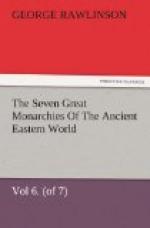If the limits of Parthia Proper be thus defined, it will have nearly corresponded to the modern Persian province of Khorasan. It will have extended from about Damaghan (long. 54 deg. 10’) upon the west, to the Heri-rud upon the east, and have comprised the modern districts of Damaghan, Shah-rud, Sebzawar, Nishapur, Meshed, Shebri-No, and Tersheez. Its length from east to west will have been about 300 miles, and its average width about 100 or 120. It will have contained an area of about 33,000 square miles, being thus about equal in size to Ireland, Bavaria, or St. Domingo.
The character of the district has been already stated in general terms; but some further particulars may now be added. It consists, in the first place, of a mountain and a plain region—the mountain region lying towards the north and the plain region towards the south. The mountain region is composed of three main ranges, the Daman-i-Koh, or Hills of the Kurds, upon the north, skirting the great desert of Rharaem, the Alatagh and Meerabee mountains in the centre; and the Jaghetai or Djuvein range, upon the south, which may be regarded as continued in the hills above Tersheez and Khaff. The three ranges are parallel, running east and west, but with an inclination, more or less strong, to the north of west and the south of east. The northern and central ranges are connected by a water-shed, which runs nearly east and west, a little to the south of Kooshan, and separates the head streams of the Ettrek from those of the Meshed river. The central and southern ranges are connected by a more decided, mountain line, a transverse ridge which runs nearly north and south, dividing between the waters that flow westward into the Gurghan, and those which form the river of Nishapur. This conformation of the mountains leaves between the ranges three principal valleys, the valley of Meshed towards the south-east, between the Kurdish range and the Alatagh and Meerabee; that of Miyanabad towards the west, between the Alatagh and the Jaghetai; and that of Nishapur towards the south, between the eastern end of the Jaghetai and the western flank of the Meerabee. As the valleys are three in number, so likewise are the rivers, which are known respectively as the Tejend, or river of Meshed, the river of Nishapur, and the river of Miyanabad.
The Tejend, which is the principal stream of the three, rises from several sources in the hills south of Kooshan, and flows with a south-easterly course down the valley of Meshed, receiving numerous tributaries from both sides, until it reaches that city, when it bends eastward, and, finding a way through the Kurdish range, joins the course of the Heri-rud, about long. 01 deg. 10’. Here its direction is completely changed. Turning at an angle, which is slightly acute, it proceeds to flow to the west of north, along the northern base of the Kurdish range, from which it receives numerous small streams, till it ends finally in a large swamp or marsh, in lat. 39 deg., long. 57 deg., nearly. The entire length of the stream, including only main windings, is about 475 miles. In its later course, however, it is often almost dry, the greater portion of the water being consumed in irrigation in the neighborhood of Meshed.




